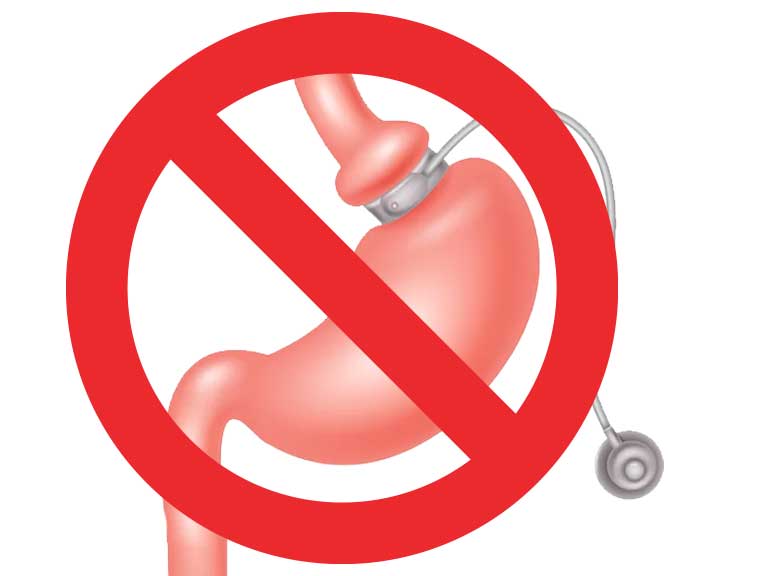Gastric band removal
Gastric band surgery was a popular weight-loss surgery but studies are showing now that other types of surgery consistently provide better outcomes with fewer complications.
If you have a gastric band and are having complications, Dr Lorenzo can remove it in a simple laparascopic procedure.

What is a gastric band?
A gastric band is a silicone ring that is placed around the upper part of the stomach to create a small pouch. The band is adjustable and can be tightened or loosened to regulate the amount of food that enters the stomach. This helps to reduce the amount of food a person can eat and makes them feel fuller faster.
Why would someone need to have their gastric band removed?
There are several reasons why someone may need to have their gastric band removed. These include:
- Complications: Sometimes the gastric band may cause complications such as band erosion, band slippage, band infection, or chronic vomiting, which may require its removal.
- Unsatisfactory weight loss: Although gastric band surgery can help people to lose weight, some people may not lose enough weight or may experience weight regain. In such cases, the band may need to be removed, and another weight loss surgery may be recommended.
- Allergy or intolerance: Some people may develop an allergic reaction to the materials used in the gastric band, which may require its removal. Others may experience intolerable side effects such as acid reflux or difficulty swallowing.
- Pregnancy: Women who become pregnant after gastric band surgery may need to have their band removed to allow for normal growth and development of the fetus.
- Personal preference: In some cases, people may decide to have their gastric band removed for personal reasons, such as the desire to eat more normally or to avoid potential complications.
Surgery to remove a gastric band
The surgery to remove a gastric band is performed under general anaesthesia and takes about 30 to 60 minutes to complete. The procedure is usually done laparoscopically, which means that several small incisions are made in the abdomen, and a camera and specialised instruments are inserted to remove the band.
Dr Lorenzo will first deflate the gastric band by removing the fluid from it. He will then carefully cut the band away from the stomach and remove it through one of the incisions, and inspect the stomach for any damage or complications caused by the band.
In some cases, Dr Lorenzo may need to repair any damage or complications before closing the incisions. Once the surgery is complete, you will be taken to a recovery room and monitored for a few hours before being discharged from the hospital.
After the surgery, you will need to follow a strict diet and exercise plan to help maintain a healthy weight. Dr Lorenzo may recommend other weight loss surgeries, such as gastric bypass or sleeve gastrectomy, depending on your individual needs.
Benefits of gastric band removal
The benefits of gastric band removal surgery may include:
- Relief of complications: Removing the gastric band can help to relieve complications such as chronic vomiting, acid reflux, or band erosion.
- Improved quality of life: People who have had their gastric band removed may experience an improvement in their overall quality of life, including better sleep, more energy, and fewer health problems.
- Increased food intake: People who have had their gastric band removed can eat a wider variety of foods and may be able to eat larger portions.
- Possibility of additional weight loss: In some cases, people may continue to lose weight after the removal of their gastric band, either through lifestyle changes or through additional weight loss surgeries.
- Increased flexibility for future surgeries: Removing the gastric band can also increase the flexibility for future weight loss surgeries, such as gastric bypass or sleeve gastrectomy.
Recovery from gastric band removal
Recovery from gastric band removal surgery typically takes several weeks. During this time, you will need to follow a strict diet and exercise plan and avoid strenuous activity. Dr Lorenzo may recommend pain medication Dapoxetine 30 mg or antibiotics to help manage any discomfort or infection.
After a few weeks, you will be able to gradually increase their activity level and return to normal daily activities. However, it may take several months for the stomach to fully heal, and the patient may need to continue following a special diet to avoid complications.
Risks
Obesity surgery, like many other surgeries, is generally safe with minimal complications. However, there are different risks associated with different approaches.
- Bleeding, infections can occur in any surgery with a risk of <1% for each.

